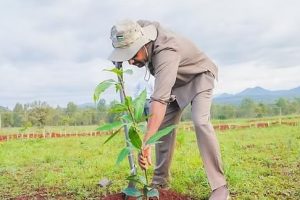
Sinai Alemu, Botanist (forest) Researcher at Ethiopian Biodiversity Institute
BY EPHREM ANDARGACHEW
Recently, planting indigenous tree seedlings get momentums and acknowledged by the concerned bodies. Planting Indigenous tree seedlings has multiple benefits namely for sustainable climate, productivity and preserving the biodiversity. Furthermore, 30 different kinds of indigenous trees suitable for various agro-ecological zones have been identified.
During his interview with The Ethiopian Herald, Ato Sinai Alemu, Forest and Rangeland Plants Biodiversity expert at Ethiopian Biodiversity Institute has elaborated the green legacy activities with a special reference the multiple benefits of planting indigenous tree seedlings. Have a nice read:
Would you tell us about the current forest coverage of the country?
In general, the forest coverage of the country has shown dramatic improvement year by year. As institution that works on forest and forest related activities we do researches. So, based on our analyses, the forest coverage of the country has shown significant change both in intensity and coverage. Moreover, the indigenous forest coverage has changed throughout the country. The forest coverages increase not only in rural areas but also city and city surrounding areas. So, currently, the forest coverage of the country has reached about 17 per cent.
There are rumors that in rural areas farmers are complaining about the adverse effects of afforestation or planting tree seedlings on farm lands in the country. How far is that true?
It is not true, because it is not only the institution but the country is also planting indigenous tree seedlings. Since 2000, the institution has been identifying places where it studies the biodiversity distribution of the country. Based on the study findings, the institution has been recommending where, which and how to planting indigenous tree seedlings. Accordingly, we work with the communities and the concerned body including Woreda and Zone administration. This helps to recuperate the endangers species tree plants. Therefore, it is not true that the green legacy or planting tree seedlings does not affect the farmers or farm land so far.
So, do you believe that the farmers are benefited from green legacy or planting tree seedlings? If yes, what are the benefits, if not, why?
It is true that farmers are the principal beneficiaries of planting tree seedlings. Because planting trees has immediate and long term benefits. The immediate benefits could be using the forest for building houses, firewood and the like while it benefits the coming generation in the long run. Apart from the immediate use of the forest, the current and next generation further use the forest by studying their chemical content and substances. Nevertheless, the farmers are benefited from planting tree seedlings since they use the forest or the trees for different purpose including medications, food, beatifying purpose and so on.
It clear that the institution has been working to the common good of the community across the nation. So, what have you done to benefits the society in this year green legacy?
As I said before, every year the institution identifies five forest which are eroded or exposed to deforestation or desertification. Then, we design rehabilitation work with the collaboration effort of the community resides the surroundings. Here from the selected five forests, one will be changed into in-situ conservation site that supervised by legal personal or entity only. So far, the intuitions with community and stockholders has changed 26 forests into in-situ conservation sites. This has importance not only the community but also the country in general.
What have you done to replace or provide indigenous tree seedlings to be planted?
Recently, planting indigenous tree seedlings has got due attention across the nation. Hence, both the government and everybody has been working on it. Nevertheless, there is a misconception that indigenous plants are not important or has no value. However, this misconception is not true. Ethiopia has indigenous trees which have timber and other related value. The seedlings are also used to conserve water resources, to maintaining soil moisture, nutrient accumulation, to resist climate pollution, helping to revitalize the ecosystem of the county.
In order to assist the policy that indicates the importance of replacing immigrant plants with indigenous tree seedlings, the institution has established seven tree seedling nurseries and two gene banks. Accordingly, seedling germination works have been held at all nursery sites every year. For instance, in this year, for green legacy the institution has prepared and deal out more than 1.6 million indigenous seedlings for planting. The good thing is these indigenous seedlings are well known by the communities with their use and purposes. Hence, the replacement of immigrant plants with indigenous tree seedlings has been going on well.
What are the benefits of planting indigenous tree seedlings for Ethiopia?
Planting indigenous tree seedlings have great importance and benefits to the nation. Since they are used to it with the soil, the environment, atmospheres and the surroundings, they could easily grow and provide the expected benefits to the community and the environment. Off course, there are complaints in the farmers’ side about planting trees seedlings in general. Nonetheless, the complaints are usually coming from those adventitious/Immigrant plants, not for indigenous tree seedlings. Because indigenous plants are known and well acquainted by the communities with their purposes and uses. Moreover, the communities recognize which seedling is important to conserve moisture, for watershed, rehabilitating eroded land and the like. Therefore, indigenous plants are important to be used for timbering and rehabilitating eroded lands.
Planting Indigenous tree seedlings has multiple benefits namely for sustainable climate, productivity and preserving the biodiversity. Furthermore, 30 different kinds of indigenous trees suitable for various agro-ecological zones have been identified.
Ethiopia’s green legacy has been expanded and strengthen year to year. This year also Ethiopia invited the neighboring countries to participate in green legacy tasks. What are the implications of inviting neighboring countries in planting tree seedlings?
The initiatives and commitment of Ethiopia to plant trees together with neighboring countries needs appreciation and gratitude since planting trees seedlings have spillover effects. Hence, it shows Ethiopian aspiration to develop together. It also indicates Ethiopian readiness to be Pioneer about planting tree seedlings, it is important to share the benefits of planting tree seedlings together mainly fighting against desertification and the like. Some of the trees that are planted are important to fight against famine and drought. They are also significant to exchange species of plants that are important for food, medication, timber and so on. With the process of planting tree seedlings, they may exchange also drought resilience trees and the like. So, inviting neighboring countries to participate in the green legacy is important.
What do the recent researches indicate about Ethiopian initiatives of planting tree seedlings?
The recent researches indicate that the growing attention and participation of high level officials in green legacy motivates the public to participate in planting tree seedlings. These has been observed both at the public and the academia. The public develop the habit of protecting and conserving natural resources while the academia gives attention on researching the nation plant resources, identifying the indigence with the immigrate one. Moreover, the recommendations of the academia help the government to work together with the concerned body to rehabilitate the eroded lands, afforestation and creating common understating of how to use our natural resources and the like. Nevertheless, much has been remains to be done.
The Ethiopian Herald July 18/2021





